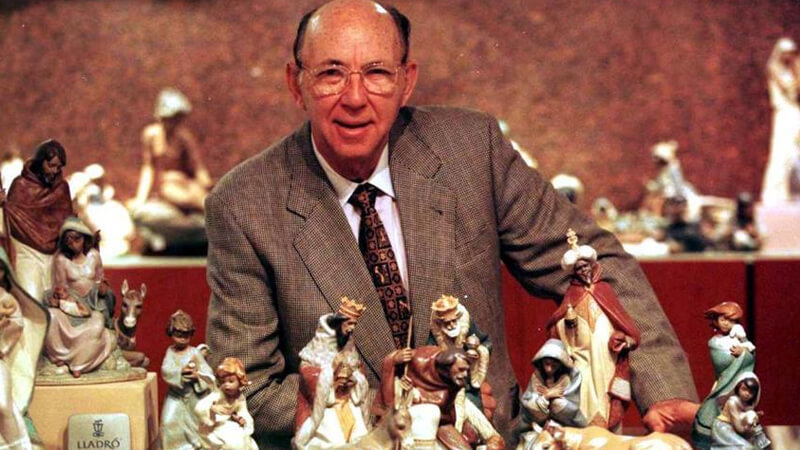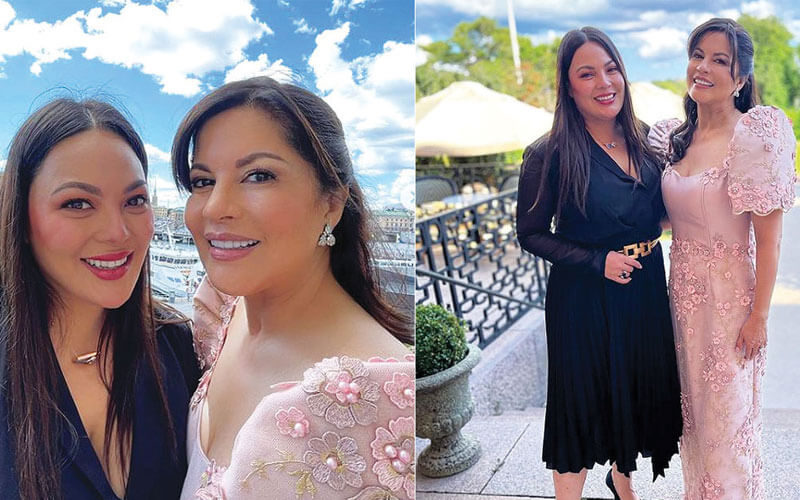José Lladro Dolz was born in 1928 in the small village of the Valencian garden of Almassera, son, together with his older brother, Juan (1926), and Benjamín, Vicente (1932), farmers Juan Lladro Cortina and Rosa Dolz Pastor.
Biography of Jose Lladro
Occupied in the agricultural work from the fourteen years, the two majors managed to study, however, the primary school and at the age of fifteen they went to work in Azulejera Valenciana.
See Also: Biography of Quincy Jones
Upon returning from military service, Juan’s artistic skills were already in general possession of the area, which allowed him to enter the prestigious Victor Nalda factory, where Jose and Vicente also joined once their obligations to the country had been fulfilled.
Then they promised their mother that they would never part and that they would pursue a common goal. In Víctor Nalda the three brothers developed their innate gifts for decoration.
But that did not satisfy his artistic vocation, so they enrolled in the School of Arts and Crafts of San Carlos, Valencia, where Joseph and Juan, in the afternoon, studied drawing, painting and decorative composition, while Vincent was dedicated to the sculpture. Several of his works from that period can be seen today at the Lladro Museum in New York.
The beginning of a big company
Soon the Lladro brothers began rehearsing and experimenting on their own in a small oven built in the courtyard of the paternal house. This activity soon became incompatible with the work in the factory, which finally had to leave, one brother after another, for divergences with the owner.
Then began a time of hardship during which they began to sell their works to earn some money.
However, at the beginning of the 1950s they had enough savings -administered by the mother- and know how to totally disassociate themselves with Victor Nalda and found his own business.
Thus, in 1953, the Lladro Dolz brothers established what was to become a company of renowned and universal vocation.
Over time, that little business of classic sculptures (decorated plates, vases, flowers and other gift items) would become a network of diversified businesses, with real estate and agricultural businesses, and even skin accessories.
However, the company that makes the porcelain, in an entirely handcrafted process, would continue to be the flagship of Lladro in the City of Porcelain, a complex built on the outskirts of Valencia.
The early years were hard. They finished 1955 with 290,000 pesetas of inventory; the following year almost reached half a million and in 1957 exceeded 900,000 pesetas of assets.
From 1958 they began to earn money, in a time of great transcendence for the family: the mother died in 1957, year in which the first store was opened, in the passage Rex of Valencia; José married in 1958 and Juan did it the following year, while Vicente waited until 1963. From the opening of the first store, the three brothers began to travel and visit national and international trade fairs to sell their figures.
In 1959, the company moved to a warehouse in the neighboring town of Tavernes Blanques, because demand had exceeded expectations.
And in 1960 the word “Spain” was incorporated into the logo as a clear expression of the company’s exporting vocation. The Lladro logo consists of a bellflower flower, very popular in the area, and a tie that represents a symbol of ancient alchemy (the union of nature with science).
Opening to the international market
In the 1960s, the company began its expansion throughout the country and placed the first link of a chain of stores abroad with its establishment in the United States, where they “came to look for us”, as José Lladro recalls, and where the company gets the third of its glob al turnover.
Until then, they made and decorated pieces of earthenware, but soon decided to experiment with other materials and other types of designs. They began with small figures who tried to imitate those of the Royal Copenhagen, considered the highest quality.
In 1970 was incorporated the line Gres, with the image of a girl reading. The peculiar luminosity of this material fascinated the clientele and the critics, and the following year arose the line of the vases, an excellent means of expression for the painters of the company.
In 1973 the Lladro already had enough capital to acquire 50% of the Weil Ceramics & Glass, which strengthened its presence in the US market. In 1974 they released the first sculptures of the Elite collection and began to apply the emblematic brilliant blue by means of a small slip placed in the base of each piece before painting it.
In 1985 the Society of Collectors was founded, which brings together more than one hundred thousand loyal customers of Lladro porcelain and who enjoy certain advantages when purchasing products with limited circulation.
In January of that same year José Lladro signed the joint venture agreement with the Japanese distributor Mitsui.
The New York Lladro Museum and Gallery was opened on September 18, 1988, at 57th Street in Manhattan and, with the founding of Lladro USA and Ordal Australia, the expansion of the company was consolidated in the United States and Australia.
From Sales to Museums
The popularity acquired by the Lladro sculptures led to the exhibition of a selection of them in 1991 at the exclusive Hermitage Museum in St. Petersburg. Since then, two pieces are part of the permanent collection of this emblematic museum: Carriage 18th century and Don Quixote.
On June 18, 1996, the Lladro Center was inaugurated in Madrid; on March 26, 1997, the Lladro Center in Beverly Hills, a large joint building of Juan Vicente Lladro, Rafael Tamarit and the renowned American architect Ki Suh Park, and in 1999, the Lladro Center in Las Vegas.
With the Inspiration Millennium collection the third millennium was welcomed and another Lladro Center opened in the heart of Sydney. In 2001 Lladro Privilege was born, a customer loyalty program.
Since the first store, opened in Valencia in 1957, the Lladro brothers have opened branches in other places in Spain and in the United States, Canada, Germany, Belgium, Italy, Great Britain, Japan, Hong Kong, Singapore and Australia.
Lladros style, always naturalistic, has evolved from the classic to incorporating a certain sentimental neorromanticism: “We want our works to have elegance, to be expressive, to breathe life, to reflect the positive values of the human being.”
In the business aspect, José Lladro stands out for his defense of the worker. It even advocates that a person who retires by age and has worked all his life in the same company, receives, besides the obligatory pension of the State, an economic compensation of the company as if it were an unfair dismissal.
At the end of the 1980s, the Lladro brothers decided to diversify the business, extending their activities to sectors such as food and agriculture, with estates in La Mancha or important and very modern citrus plantations in Valencia, in addition to a significant participation in the importation of cacao Natra, or real estate, through the Rosal Society.
Recently they also entered the goldsmith’s field through the jewelery firm Carrera y Carrera, as well as in the wine sector (Torre Oria wines) or the hotelier (Occidental Hoteles). They also have a more than symbolic participation in the exploitation of the Valencian theme park Terra Mítica.
New Expansion Projects
José Lladros expansion targets include two other macromarkets: India, with almost 1 billion people, and China, which exceeds 1,200.
The management of José Lladro has been widely recognized. In 1993 he received the Prince Felipe Award for Business Excellence, the most prestigious in the world of business; on December 28, 1995 he was appointed counselor of the Spanish Institute of Foreign Trade, and in September 2001 he was appointed president of the Royal Academy of Valencian Culture.
Simple and friendly, he loves his neighbor, he suffers for the inhabitants of the Third World and he worries about the well-being of his workers, for whom in the Porcelain City he has built sports fields, nurseries and other services.
In addition, it subsidizes the exits to camps of the children of its employees, among other privileges that enjoy the more than 2,000 hired by the company.
Generational Relay
To give continuity to their work, the three brothers have given specific training to one of their children. Thus, in 1984, Rosa, Mamen and Juan Vicente, sons, respectively, of Juan, José and Vicente, became part of the management team and, later, the board of directors. Rosa graduated in fine arts and is in charge of the image.
Juan Vicente is an architect and overseer of creativity and research and development (R & D), while Mamen, a business graduate, controls strategic business management, logistics and distribution in Asia and the Pacific.
Jose Lladro has captured his memoirs in a book entitled Passenger of Life, published in the spring of 2002. In it he reveals the avatars of his family and company and tells an endless number of anecdotes.
Among them was a very curious one: he gave the Three Kings to Pope Paul VI, but he recycled them by giving a statue to each of the astronauts who traveled to the Moon in 1969 -Armstrong, Aldrin and Collins-, because he considered that they were the messengers of God in the world.




